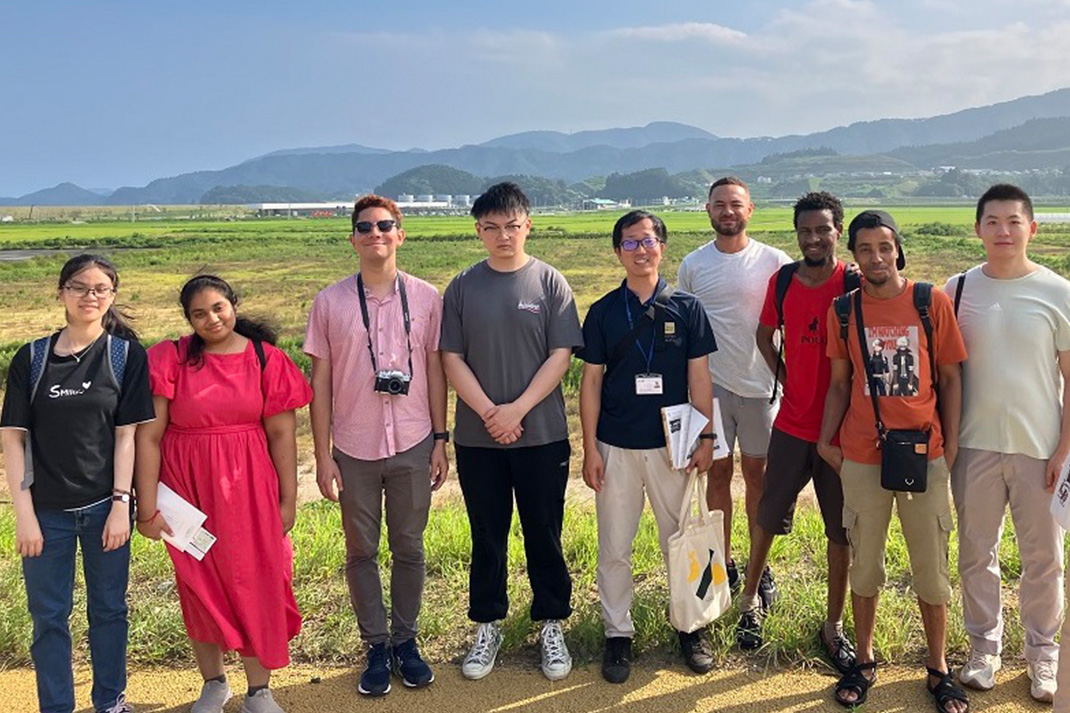Rikuzentakata Field Trip
Master of Social Development and Administration Course (MSDA)
Aug 31, 2023
OVERVIEW
The MSDA course offers a field trip to Rikuzentakata City for first-year students as part of their off-campus research activities. This is intended not only to observe disaster countermeasures, but also to deepen exchanges with other students and faculty members. Students from other countries have a fulfilling opportunity to enjoy the Japanese lifestyle and culture away from the city. This is an enriching opportunity for them to deepen the meaning of studying at a Japanese university.
MSDA Field Trip(2023.8/6-8/8)

At Fumonji Temple
This was our second visit, following last year, but it was first time to visit Rikuzentakata Museum and Fumonji Temple, which was used to receive volunteers after the disaster, were unforgettable stories told by the local people.
MSDA students appreciated the opportunity to recognize the importance of disaster risk management, learning about the role of social connections and the resilience of the local people who make continuous efforts to recover from the damages of the disaster.
BACAR Anza Bacar

On the first day, after arriving in Rikuzentakata, we went straight to Tsunami Memorial Museum where the atmosphere was wonderful.
Then we were taken to delve into the Tsunami memorial in which we had four moments for learning: Tracing History; Learning the Facts; Moving towards Reconstruction Together; and Learning lessons.
I also learned a lot about Disaster management, and a bit more about Japanese society and culture as I went to see a very beautiful traditional festival of Rikuzentakata . I experienced the locally produced Japanese cuisine, especially seafood, which tastes different from my country.
I also had a brilliant opportunity to visit the local people in Nagahora village. They were very humble, open, and polite people.
POHIVA Samiuela

ZUNIGA RUBI Carlos

MONDLANE Grácio Ângelo Antonio

On the second day, two lectures were delivered by persons in charge of important projects in the community; aiming at attracting young people to that place as well as to revert what they called the bucket theory. Then, we visited the remains of temporary housing build on the playground of the Rikuzentakata Higashi Junior High School. Then,we move to the Buddhist temple where we had a lecture regarding the role of the Buddhist community during the recovery process.
On the third day, we had a lecture concerning the evacuation process, and food distribution logistics, and the most important lecture was about how the local people in Nagahora area survived the damages of the 2011 earthquake and tsunami, consolidating their community bonds.
ASHOKKUMAR Srinidhi

I was also surprised at the contributions of new businesses in the recovery process and how people from other areas of Japan have more to Rikuzentakata City for aiding the recovery. I was empowered to know that these enterprises have become agents of change in the city through innovation and circular economy while reviving the local economy. This trip demonstrated the role of businesses in rebuilding communities and showcased the scopes of positivity amongst adversity.
BAI Hao

In this land where Buddhism and Shinto coexist, people have realized this for thousands of years, celebrating and commemorating the gifts of nature, gods, and unknowns in their way.
From the miracle pine tree under the tsunami to the reconstruction of self-sufficient villages after the disaster, although life is small, it is tenacious. During the three-day trip, I was overwhelmed by the beauty of Rikuzentakata, impressed by the love of the residents for this land, and touched by their courage and hard work. We are used to the urban life, but in Nagahora Genki Mura, this idyllic way of life is yearning, everything is refreshing and feels back to basics. Sustainable development may be a very difficult topic, especially in Japan, where natural disasters are frequent. However, the attempts and challenges here are a very good case and direction. I have really learned a lot. Thank you, the staff of MSDA at Rikkyo University, and Arigado, Rikuzentakata.
NGUYEN Thao Nhi

YE Zhongqi

Listening to their stories reminded me of the power of human connection and the importance of community. This trip was more than just an educational excursion; it was a lesson on resilience, hope, and the eternal flame of the human spirit, even in the face of overwhelming odds.
Furthermore, a heartfelt thank you to the teacher who accompanied me on this journey, their guidance and insights greatly enriched the experience.


RECENT TOPICS
Oct 17, 2025
MSDA Rikuzentakata Field Trip 2025
Master of Social Development and Administration (MSDA) Course